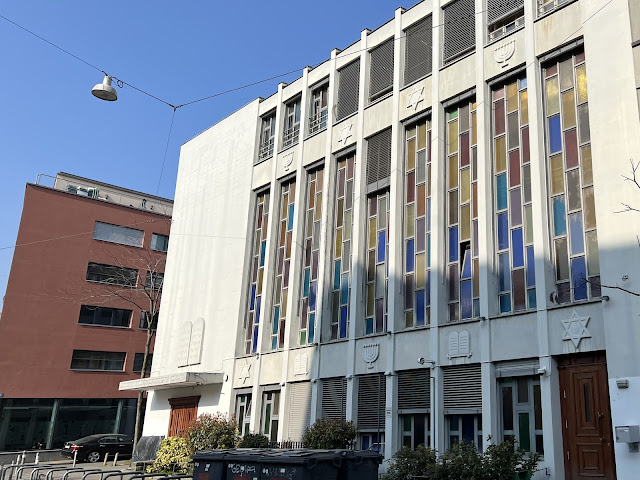Welcome back to Every European City, our voyage of discovery using Zurich as a case study.
Today, we’re checking off one of the more elusive items from Itchy Feet’s map: Hipster Home Brickworks.
Unlike parts of England, the Netherlands, or northern Germany, where red brick homes are practically a birthright, Zurich prefers stone, stucco, and sleek minimalism. With little local clay and a strong affinity for clean lines, red brick buildings are rare gems here.
There is still hope, though. Let’s turn to one of the city’s most fascinating and quietly evolving areas: Wiedikon, Werd, and Albisrieden.
Zurich’s Jewish population — about 8,000 to 10,000 people, or 2% of the city — may be small by international standards, but it holds a vital place in Swiss cultural life. Cities like New York, Paris, and London each have Jewish communities in the hundreds of thousands, highlighting Zurich’s role as a vibrant yet more modest European center of Jewish life.
Wiedikon is home to a long-standing and active Jewish community, with several synagogues, including the prominent Agudas Achim Synagogue.
On Friday afternoons, the neighborhood takes on a special rhythm as Orthodox Jewish families head home before sunset, shops close early, and kosher bakeries bustle with last-minute shoppers picking up challah, wine, and other Shabbat essentials.
Historically, Wiedikon was a diverse, working-class quarter — home to immigrants and a thriving Jewish community. Over the years, it has become a melting pot of cultures and stories, contributing to its distinct urban character.
Today, the area is undergoing a transformation. Gentrification is bringing in younger, more creative residents drawn to its charm and potential. This mirrors a broader European trend: once-overlooked neighborhoods are being revitalized, sometimes at a cost.
Enter Hipster Home Brickworks — where historic architecture is being reimagined to meet modern needs.
Take The Hubertus, for example, a striking example of adaptive reuse, blending residential and commercial spaces in a way that enriches the district’s atmosphere.
Or Brasserie Freilager, once a bonded warehouse, now a lively complex of apartments and two Italian restaurants.
These developments add vibrancy and attract investment, but also raise housing costs — a familiar story in gentrifying neighborhoods. Longtime residents increasingly face displacement as Zurich’s real estate market tightens.
Homeownership in Switzerland is among the lowest in Europe, with only about 36% of the population owning their homes. In Zurich, that percentage is even lower. With the vast majority renting, access to affordable housing isn’t just a personal concern — it’s a widespread urban issue.
The Covid-19 pandemic accelerated these shifts. Suburban homes gained appeal, offices became less essential, and residential demand surged. Meanwhile, Zurich’s booming tech and finance sectors, led by companies like Google, which has had its European HQ here since 2004, pushed real estate prices even higher, driven by salaries far above the local median.
In this landscape, Genossenschaftswohnungen (cooperative housing) provide a crucial counterbalance. Making up about 18% of Zurich’s rental market, these cooperative apartments aim to remain affordable and socially inclusive. Spread across various districts, they offer a degree of housing stability, though demand far outpaces supply. Waiting lists can stretch for years, sometimes over a decade.
Through cooperative housing, Zurich is working to preserve diversity and resist unchecked gentrification, trying to strike a balance between modern growth and social equity.
And to lighten this somewhat heavy topic — here's a little gem I found: a teddy bear watching from a balcony, quietly witnessing the changing face of the city.
How do you feel about balancing heritage, affordability, and urban renewal?









You made Wiedikon feel so alive and real. It's such a tricky thing, trying to keep the soul of a neighborhood while everything around it changes. And that little teddy bear watching it all? Just perfect.
ReplyDeleteI like balancing Tamara, I especially like preserving some of the older buildings but I also know that renewal is needed to keep up with the times. I love the two teddy bears watching the change happening in their neighborhood. The brickwork is gorgeous and I'm wondering if that might be a "thing of the past" for some developers? I love the combination of the white and red brick and when reading the section about the Jewish population it brought back fond memories of Roy A. when he would blog about the Shabbat and other Jewish holidays. I sure miss his history lessons.
ReplyDeleteI like preserving our heritage. The older buildings have more individuality, warmth and character. In the newer parts of our city, all the houses look the same - like the song Little Boxes.
ReplyDeleteSuch a thoughtful glimpse into Wiedikon’s story. I’m glad to see efforts to keep the community’s heart alive amid all the changes!
ReplyDelete